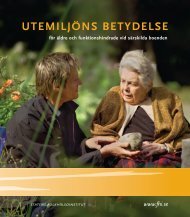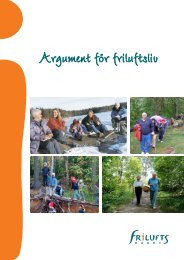Green Care: A Conceptual Framework - Frisk i naturen
Green Care: A Conceptual Framework - Frisk i naturen
Green Care: A Conceptual Framework - Frisk i naturen
You also want an ePaper? Increase the reach of your titles
YUMPU automatically turns print PDFs into web optimized ePapers that Google loves.
4.3 Horticulture as therapy<br />
Horticulture, in many different forms, has been used as a therapy or as<br />
an adjunct to therapy in the treatment of disease. It has also been used to<br />
achieve social and psychological benefit for disadvantaged individuals<br />
and communities and to promote health, and physical and psychological<br />
well-being. Horticulture and gardening are still used by many occupational<br />
therapists both to promote the development of motor skills and also to<br />
develop social skills and provide social opportunities, particularly for those<br />
with mental health problems.<br />
Alongside the use of horticulture in occupational therapy, the practices<br />
of ‘horticultural therapy’ and ‘therapeutic horticulture’ (see Sempik et<br />
al, 2003) have developed. These approaches have a recognised format<br />
and structure, pedagogy and in some countries (for example, the US)<br />
a professional organisation. The terms ‘horticultural therapy’ and<br />
‘therapeutic horticulture’ are frequently used in the literature, sometimes<br />
interchangeably, to describe the process of interaction between the<br />
individual and the plants or gardens and (in most cases) facilitated by a<br />
trained practitioner. The UK charity Thrive uses the following definitions<br />
of Horticultural Therapy and Therapeutic Horticulture which were agreed<br />
by UK practitioners at a conference on Professional Development held in<br />
September 1999:<br />
“Horticultural therapy is the use of plants by a trained<br />
professional as a medium through which certain clinically<br />
defined goals may be met.”<br />
“Therapeutic horticulture is the process by which individuals<br />
may develop well-being using plants and horticulture. This is<br />
achieved by active or passive involvement.” (Growth Point,<br />
1999, p. 4)<br />
The distinction is that horticultural therapy has a pre-defined clinical<br />
goal similar to that found in occupational therapy whilst therapeutic<br />
horticulture is directed towards improving the well-being of the individual<br />
in a more generalised way. Recently the term ‘Social and Therapeutic<br />
Horticulture’ (STH) has become widely used (particularly in the UK) since<br />
social interactions, outcomes and opportunities are an important part of<br />
the activities and processes of therapeutic garden projects. Sempik and<br />
40 <strong>Green</strong> <strong>Care</strong>: A <strong>Conceptual</strong> <strong>Framework</strong>















